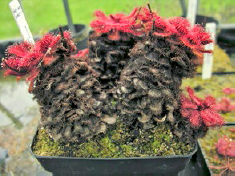
Evergreen species of Drosera (here, D. slackii) can, over time, develop a substantial pedestal.
A little about annual maintenance. Apart from keeping plants wet and sunny in the summer and adhering to the three golden rules, most carnivorous plants require very little in the way of everyday care. In the autumn, deciduous species will need tidying up. Annual clean-up can seem a chore, especially if you have a large number of plants. But alas, it is unavoidable—an essential aspect of the cultivation of carnivorous plants.

Evergreen species of Drosera (here, D. slackii) can, over time, develop a substantial pedestal.
Each of the two most prominent genera has its own general maintenance needs. Sarracenia plants die back at differing times over the autumn and winter. Once the leaves have browned off sufficiently, the old growth must be removed—a simple process we’ll look at in more detail later. Those species of Drosera that die back to their roots or form winter resting buds can simply be cut back with scissors, removing the dead growth. The evergreen species, such as Drosera capensis from South Africa, develop a skirt of dead leaves around the base of the plant, which helps support the upright stem and can be left intact—as can the old leaves under the rosette species. Over time, the dead leaves form a pedestal of old growth under the live leaves.
TOOLS
If you are fortunate enough to possess a substantial number of plants, it is wise to avail yourself of appropriate tools for the job. Good-quality pruning shears (secateurs) will pay dividends, and the extra investment will give you years of service around the entire garden.
Sharp shears of the type used for topiary are, for me, a real asset, saving me many hours. They self-sharpen as they’re used, with the edges of the blades rubbing together, enabling you to cut through a large number of wiry sarracenia leaf bases in one cut—great for larger specimens, and for saving time.
Long tweezers can be extremely useful for removing dead leaves from sticky-leaved plants, for plucking out seedlings, and for any one of a number of tasks where large or cold, numbed fingers just won’t suffice. Again, go for quality—they will be much sturdier. Mine are from a bonsai-growing nurseryman friend and have a flattened, blunt blade at the top which is ideal for making holes in the potting mix when transplanting.
A sharp pair of scissors is always helpful for more delicate pruning of fine plants, and some very good ones are available from specialist bonsai growers. All the tools you use should be kept in good condition, cleaned regularly to eliminate any risk of cross infection, and sharpened when necessary. Specific sharpening stones are available for pruning shears, and they should be used regularly to ensure you are performing clean cuts with minimal effort.
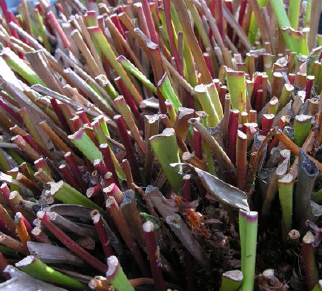
A large plant such as this Sarracenia minor is best tackled with topiary shears.
Cleanliness is paramount, especially as you will invariably use your tools around the garden. After each use a quick wipe with disinfectant will sterilize the blades, and a good rub with one of those baby wipes will remove any sap residue. Some advocate the use of a strong bleach solution, but this is poisonous to all green plants, so I avoid it. A squirt of oil after cleaning will prevent any rust developing on the metal surfaces, and keep the moving parts lubricated.
PESTS AND DISEASES
It can seem incongruous to learn that carnivorous plants can be prone to pest attacks when you consider their nature, but like any group of plants, there is a veritable army of insect warriors on the march. The reason the plants cannot defend themselves is that the pests usually attack developing leaves. The pests are also usually very small and elude capture.
There are differing methods of control which I’ll suggest, but first a mention of spraying. This is a controversial subject, but most insecticides are fine to use on carnivorous plants, though some care or experimentation should be used with glandular-leaved plants such as the sundews and butterworts. There’s a fine balance here. I find a close eye and a reactive approach work well, rather than overspraying and risking the development of a local resistance to the chemicals. This can also be avoided by changing the insecticide on a regular basis. Some offer a systemic cover, in which the active ingredients are taken into the plant’s system, where they remain and offer a period of protection, usually around six weeks. I feel these claims are a little overstated, so a keen eye is the best way to prevent a pest from gaining a foothold. Ready-to-use varieties are ideal and convenient. If you are using a concentrate, mix it according to the manufacturer’s instructions. The available range changes as it is discovered that chemicals which have been used widely are in fact somewhat dangerous to health or the wider environment, but here are a few currently in use. I have listed the active ingredient rather than the proprietary name, which varies from country to country.
ACETAMIPRID A good all-around insecticide sold by Scotts under the name Bug Clear Ultra in the UK and Ortho Bug-B-Gon: Systemic Insect Killer in the United States. Available as a concentrate and a ready-to-use spray, and again I’ve used this on all the genera covered in this book.
THIACLOPRID Another good insecticide. Also available as a ready-to-use spray and concentrate, this is a systemic product, and I have used it on all the genera covered in this book.
ORGANIC SPRAY There are a few organic insecticide sprays available which contain fatty acids. These have their benefits, especially where pets and children may be in close proximity. The way they act ensures no risk of localized immunity to the active ingredients. Bayer manufactures a good example which seems to be safe to use on dionaeas, droseras, and sarracenias.
BIOLOGICAL CONTROLS Biological controls are available for many greenhouse pests, but their employment is rarely justified for a small collection unless the infestation is severe. There is also the very real risk of plants catching “good bug” predators, especially if they have a penchant for the nectar the plants produce.
FUNGICIDES Here’s where the old adage of an ounce of prevention being worth a pound of cure certainly rings true, as there appear to be no currently available fungicides which will prevent grey mould (Botrytis). Remember my earlier comments about good air circulation.
Pests
ANTS
Ants are rarely an issue themselves. Quite the contrary, it’s quite a sight to see a long trail of them moving along the benching and up a Sarracenia pitcher, where they fall one after another into its depths. However, their habit of “farming” some pests can be a nuisance. Plants grown outside are not usually bothered by their nesting habits, if the potting mix is kept wet enough.
APHIDS
There are a number of species of this all-too-familiar garden and greenhouse pest. They are typically ¹⁄₂₅ to ⅛ in. (1 to 3 mm) in length and a green or black colour, often forming a large colony which can clothe entire shoots. Their success lies in their prolific breeding habits, meaning that an infestation can take hold surprisingly quickly. They are sapsuckers, feeding through a sharp stylet which they insert into a plant’s vascular system to feed, causing disfigurement to the emerging leaves—generally the first sign that they have attacked your plants. Another side effect is sooty mildew (more on this later), the by-product of ants which will “farm” aphids to feed off the sweet exudates they produce. A more sinister side effect is the transference of plant viruses while aphids are feeding, which although very unlikely with carnivorous plants, is still worth bearing in mind. A small number of aphids can simply be squashed between the fingers, but if you feel squeamish doing this, or if the infestation is heavy, you can either submerse the whole plant in a bucket of rainwater for twenty-four hours, which will drown them, or spray with an insecticide.

Deformed leaves, the sign of aphid damage.
Birds are an occasional pest, especially when they learn a free meal is to be had in the guise of insects caught within Sarracenia pitchers.

Although not usually a major pest, caterpillars can cause severe damage, as here on a leaf of Nepenthes burbidgeae.
BIRDS
Not your usual suspects, and I can remember only a couple of years when an enterprising bird learned to rip the Sarracenia pitchers open to retrieve a free meal (coincidentally, it happened while writing this book). Thankfully, the trick appeared to be forgotten the following season. They can be a problem when trapped in the greenhouse and disoriented, flying at the glass to escape and knocking plants and pots over. Some birds seem more intelligent than others. Wrens frequent the nursery on a regular basis, flying around and through, completely unfazed by my presence. Blackbirds and blue tits, however, are carefully ushered out.
If you live in a rural area as I do, be aware of pheasants. They are without doubt the stupidest of all creatures and can cause considerable damage, both to plants and bench linings, with their sharp claws. They do, however, roast well.
CATERPILLARS
Caterpillars are another of those casual pests. Our plants aren’t their usual diet, but occasionally they bite the soft young growth. Random holes and orange-coloured excrement announce their handiwork, often in the autumn for some reason, when the last pitchers are produced on the sarracenias, and when the damage is rather superfluous due to impending dieback. Again, manual removal is usually all that is required; insecticidal intervention is not normally needed.
Carnivorous plants are the perfect subjects for introducing plants to children, and I cover some educational ideas in the last chapter of this book. However, in the greenhouse, especially unsupervised, they can amuse themselves by closing all your flytraps, or checking to see if the Nepenthes lids move (they don’t—unfortunately, they snap off), or running curious fingers through your sundews. This is all fine if you don’t mind their hands-on approach—there will be no long-term damage. But having once been setting up my display at a flower show, only to find my son doing all of the aforementioned to my display plants, I can fully appreciate the potential carnage and horror! (I should add that he was only six or seven at the time.) Joking aside, while kids are young, do allow them to touch the plants in a controlled situation, explaining the hows and whys of such interesting living things.
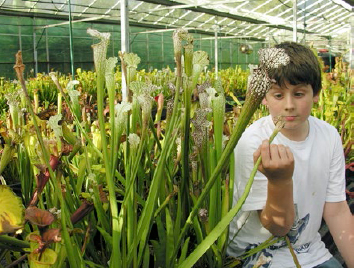
Allow kids a supervised, hands-on approach to your plants. Get them interested early. Balls and associated projectiles are the primary cause for concern.

A mealy bug on a Sarracenia pitcher leaf.
MEALYBUGS
Another soft-bodied, sap-sucking insect which can be persistent and requires a careful regimen of treatment to eradicate. There are many species, but typically mealybugs are oval-shaped, segmented insects to around ¹⁄₅ in. (5 mm) long, a whitish grey in colour, with two filamentous spurs on the rear end. Their preferred carnivorous hosts in cultivation are sarracenias. Mealy bugs exude a white, waxy material, which resembles cotton wool, in which they hide and lay their eggs. As they feed, they also excrete a sweet material known as honeydew, which, as with aphids, can lead to sooty mildew. Clusters of mealy bugs can be found at the base of leaves, and their population increases in the autumn, although they are active during the entire growing season. Control can be tricky; the key is understanding their life cycle, which takes approximately thirty to forty days to complete. Life cycles often overlap. A spray with a suitable insecticide will remove any live insects, but will not kill the eggs, which will continue hatching. Two or three subsequent applications at two-week intervals should solve the problem. It is this phenomenon that has prompted the assumption that they are difficult to eradicate.
PITCHER PLANT MOTH AND PITCHER PLANT RHIZOME BORER
These two pests are confined to the natural range of Sarracenia in North America, and are (thankfully) absent in the UK. The caterpillars of the pitcher plant moth species consume the plants’ pitcher walls, causing them to collapse and topple over. The rhizome borer, as the name suggests, eats into the rhizome, leaving a trail of orange-coloured droppings. (Rhizomes are swollen, horizontal underground stems that serve as plant storage organs, from which shoots and roots grow.) Both can be controlled by a suitable insecticide and prompt removal of infected growth.
RABBITS AND DEER
Rabbits are by far the most troublesome and destructive pests I encounter. These insidious creatures dig up or eat just about everything I plant, from Sempervivum and even Agave, to roses. They strip the bark from trees and shrubs, and treat my garden as a vegetarian smorgasbord. However, they do leave the many Sarracenia plants I have outside alone, and I have never seen a rabbit showing the remotest interest in them. I take my revenge on these mammalian menaces, and eat them occasionally, which provides a degree of satisfaction. Like rabbits, deer appear to show a similar disdain for our plants and are therefore not a concern.
RED SPIDER MITES
These tiny red-coloured mites, which are not spiders, are only ¹⁄₅₀ in. (½ mm) in length. They are serious crop pests in some countries, and are usually noticed when they have produced a substantial colony within a silk tent. They suck the contents from individual cells, causing brown spots and seriously impeding a plant’s photosynthetic abilities. Although a greenhouse pest, red spider mites prefer somewhat drier conditions than carnivorous plants, so are less likely to be encountered than other pests. They can be destroyed by an appropriate insecticide/miticide (check the label to be sure).
Rodents will generally appear in the autumn, a greenhouse being ideal winter quarters—especially if it’s a heated enclosure. In a well-maintained house with little in the way of clutter on the floor, they are unlikely to arrive. In the nursery they are a problem, and an autumnal bait keeps them at bay. Very occasionally, mice and rats will eat the rhizomes of sarracenias, though I have only seen this once in the nursery, a number of years ago.
SCALE INSECTS
There are many species of the sap-sucking scale insect, though the typical greenhouse variety is small, flat, and oval, with a light tan colour, to ¹⁄₅ in. (5 mm) in length. They are not as prolific as mealy bugs, but their treatment is the same. They too produce a sweet exudate which encourages the growth of sooty mildew.
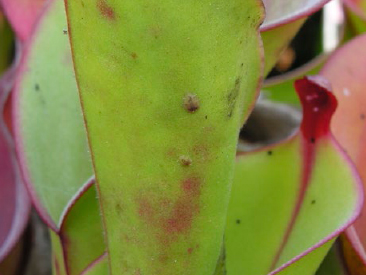
Scale insects are usually found in small numbers, here seen on a Heliamphora pitcher.
SLUGS AND SNAILS
These mollusc pests aren’t usually problematic. They seem to graze casually on the likes of sarracenias rather than do any real damage. However, they do have a penchant for, and can be destructive to, the soft, fleshy leaves of butterworts (Pinguicula). Active in the cooler temperatures of night, they nibble away while you have your feet up, leaving a trail of destruction and excrement over your pots. If you have a problem, a trip to the greenhouse at night will catch them out and about, so they can be manually removed. A few slug pellets on the floor of the greenhouse should stop any new arrivals, but be careful not to allow other animals or children to come into contact with the pellets.
SQUIRRELS
Like birds, squirrels can be destructive if they feel trapped in a greenhouse. They do like to bury nuts, though, and in the spring, I always find a number of hastily buried walnuts in pots. A word of warning: never corner a squirrel.
Thrips are small, winged insects (though poor flyers), around ¹⁄₂₅ in. (1 mm) in length and black in colour. They will eat the surface layer of leaves, mainly species of Sarracenia and Darlingtonia. Control them with an insecticide.
VINE WEEVILS
This serious garden pest has become very prevalent in recent years. The issue isn’t the ½-in.- (1-cm-) long black adults which nibble leaves, producing characteristic semi-circular notches. It’s the pale larvae, which are of a similar size and consume the roots, destroying the plants—in our case, mainly sarracenias. Fortunately for fanciers of carnivorous plants, the larvae easily drown, and the adults cannot swim, so a good depth of water maintained under your plants will act as an effective barrier. This is an important consideration for plants kept outside, where there should be either a barrier between the edge of the water tray and the container housing the plants, or a high water line to ensure the potting mix is saturated.
Diseases
GREY MOULD
Generally regarded as the nemesis of carnivorous plant growers, grey mould (Botrytis cinerea) is a fungal infection that attacks dead plant growth, predominantly on sarracenias. This is definitely a case where prevention is better (and easier) than cure. The removal of such material and good air movement virtually eliminates the risk of it developing.
If it does occur and has spread to live growth, you will see that an entire growth point (crown) has been infected. If there are a number of growth points on the plant, then you have plenty of material and don’t need to worry about losing the plant. If it is a single-crowned plant, you have a problem.
The first thing to do is remove the affected growth, which involves cutting the point off, leaving a stub of white rhizome (the rhizome can very rarely be flushed pink). If the rhizome is brown, it is still affected and further surgery is required until you reach clean material. Wipe the pruning shears with disinfectant after each cut to ensure you do not infect healthy tissue.
Grey mould attacking a Sarracenia leucophylla specimen. Note how the entire growth point is affected.
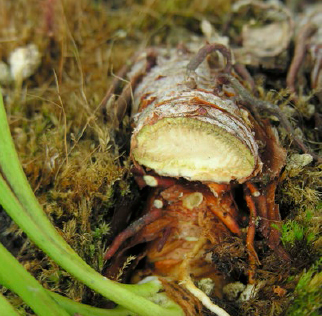
Remove the growth point so that only white tissue remains.
A large plant can usually breeze through this kind of treatment, but a single-crowned individual may be left as a rhizome cutting. Other genera are rarely affected in the same way, but a watchful eye is warranted. Interestingly, Botrytis is the historical “noble rot” referenced in winemaking, describing when grey mould covers grapes and increases sugar levels, accounting for the smooth sweetness of dessert wines.
SOOTY MILDEW
I’ve mentioned sooty mildew a few times already, as it’s associated with some of the pests listed previously. The truth is, it’s not all that bad, and is often a handy indication of an infestation of some sort. It is found on most Sarracenia plants by mid- to late summer, because it also develops on the nectar produced by the plants, even in the wild.
It manifests as a black deposit over the leaf surface, and only becomes detrimental if it covers a substantial area and can affect a plant’s ability to photosynthesize. If it appears heavily over the base of the plant (again, especially species of Sarracenia) it is almost certainly the result of a pest attack. When it shows up on the lids and throats of the pitchers (and it will), there is usually no cause for concern. If it bothers you, remove with a soft, wet cloth.
You can see the pattern of sooty mildew following the nectar glands around the edge of this Sarracenia flava lid.
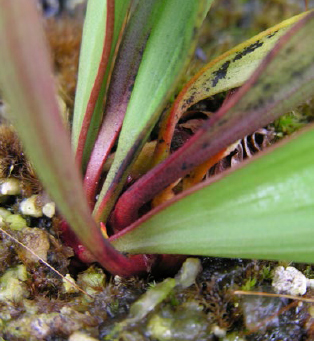
Sooty mildew will also colonize the leaves farther down. Here you can see it at the base of Sarracenia minor. This small amount is quite normal, especially later in the summer.
FEEDING
Feeding may seem a little at odds with our subject matter—after all, why would we need to provide food for plants so adept at feeding themselves?
The answer lies in supply and demand. In the conservatory during summer months, there is no paucity of insect life on hand to satisfy the requirements of our plants. However, in the confines of the terrarium, or for a not insubstantial number of winter-growing plants, things are a little different. There are times when feeding is recommended, though it is not absolutely essential. Plants will still grow, just not as quickly and vigorously as when given a food source, so there are definite benefits. There is also the issue of frequency. Perhaps it’s the erroneous animal link that people attach to carnivorous plants, but there is an assumption by many that the plants need feeding two or three times per day. But these are not animals and a long period without food will do them no harm. If your plants are outdoors or in a greenhouse/conservatory, they will at times catch a huge number of insects and should be left to their own devices.
Let’s first look at what not to feed your plants. I have heard from countless people what they have fed their plants—usually followed by a comment like “ … and then the leaves all turned black.” So here are a few examples of things you don’t feed carnivorous plants, taken from anecdotal reporting.
Ham and other processed meats, including hamburger
Cat food
Chocolate and other forms of confectionary
Cookies
Dog food
Lego bricks
Milk
Although some of these contain nutrients beneficial to the plants, they do encourage leaves to rot, especially if given in larger-than-necessary quantities. The best policy is to avoid feeding carnivorous plants anything other than insect matter.
In a terrarium, a few insects every couple of weeks will be more than sufficient, administered directly to the traps. Don’t be tempted to overfeed them in the hopes that you’ll find Audrey II the following morning; you will simply succeed in rotting the leaves in the high humidity and creating an unpleasant smell. The size of the trap has a direct correlation to the intended size of the prey, so don’t attempt to feed a hornet-sized insect to a small sundew.
There have been many suggestions over the years to feed carnivorous plants with dilute concentrations of proprietary plant foods, something I’ve never found to be necessary. To keep things simple, let’s disregard this debate. The best items to feed your plants are those handy, self-contained insects which they are designed to consume, and these can be live, dried, or even tinned.
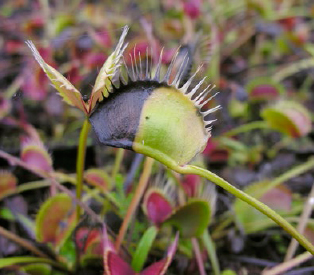
Some dieback of traps is to be expected, especially older leaves which have reached the end of their lifespan.
With live insects, the cheapest and most convenient method of gathering is to wander around the garden in the darkness of evening, looking under stones and on the undersides of leaves, collecting whatever you find. A good range of insects can be captured in this way, and under cover of darkness you are less likely to be seen by your neighbours, who will already have their reservations about you, since you grow carnivorous plants. Any insect will suffice, the plants are not selective about what they eat—though avoid earthworms, because they have the ability to escape most traps. In pitchers, they will produce a nasty smell.
Woodlice (sow bugs), flies of all denominations, beetles, caterpillars (though these can literally eat their way out of a trap), wasps (best avoided if you don’t want sore fingers), spiders, and small grubs are all suitable. They can be fed directly to your plants. Remember to match the size of the prey with the size of the trap—insects should be large enough to be of value to the plant, but not so large that they kill the leaf.
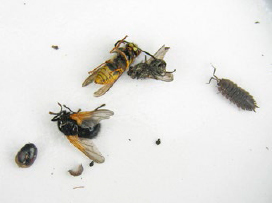
Suitable insects for our plants. Essentially, if it moves, it’s fair game.
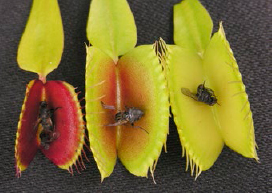
Naturally caught insect prey in dionaea leaves.
If you prefer not to stalk around your garden in the darkness, you can always buy insects. A wide variety is available from reptile suppliers online. The most convenient is the common brown cricket, Acheta domesticus, which is bred extensively as a live food. They are available in a variety of sizes, known as instars (sizes go from first instar to second instar, and so on, as they moult and become progressively larger).
The biggest challenge is catching them in the box in which they are supplied. Here, a pair of long tweezers will assist greatly. A word of caution: if you grasp one by a back leg, they will often detach that leg and hop away, usually across the living room floor, where they become difficult to recapture. I well remember being in trouble for just this misdemeanor as a child (when I kept tropical frogs). Adding insult to injury, my mother had a strong aversion to crickets! Placing the crickets in the fridge (not the freezer) for ten minutes will slow them down and make them easier to handle.
Grasshoppers are also available in a variety of instar sizes, but have the disadvantage of being able to jump great distances, making them more difficult to round up in the house.
Freeze-dried insects are a very convenient food for sticky-leaved plants and I use dried bloodworm, which is the larval stage of a midge, for feeding my winter-growing sundews. Dried bloodworm is also ideal for smaller terrarium plants.
A range of canned insects is available in some countries, though not in the UK. These are suitable, but once the can is open, its contents need to be used quickly.